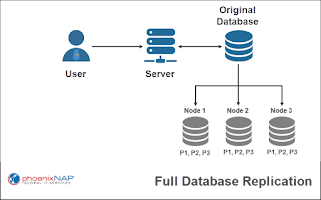Ensuring Data Availability and Consistency
In the dynamic landscape of data management, ensuring data availability and consistency is paramount for the success of any organization. As a third-party observer, we delve into the world of data replication solutions, exploring their significance, benefits, and how they contribute to maintaining data integrity and accessibility.
Understanding Data Replication Solutions
Data replication solutions refer to
technologies and strategies designed to duplicate and synchronize data across
different systems, databases, or locations. The primary goal is to ensure that
data remains consistent, accurate, and available to users, applications, and
processes whenever needed.
Importance of Data Replication
In today's data-driven world, organizations
rely heavily on accurate and up-to-date data for decision-making, analytics,
reporting, and more. Data replication solutions play a critical role in
addressing various challenges and requirements:
Business Continuity: Data replication
solutions contribute to business continuity by creating redundant copies of
data. In case of hardware failures, system crashes, or disasters, organizations
can quickly switch to the replicated data, minimizing downtime and ensuring
continuous operations.
Disaster Recovery: Natural disasters,
cyberattacks, and data breaches can result in data loss. Data replication
solutions provide a safety net by maintaining mirrored copies of data in remote
locations, allowing organizations to recover data in the event of a
catastrophe.
Data Distribution: Many organizations have
a global presence, and data needs to be accessible across geographical
boundaries. Data replication solutions enable data to be distributed to
different locations, ensuring consistent and timely access.
Analytics and Reporting: Accurate and
up-to-date data is essential for effective analytics and reporting. Data
replication solutions facilitate real-time or near real-time data availability,
enabling organizations to make informed decisions based on the latest
information.
Types of Data Replication Solutions
Snapshot Replication: This method creates
periodic point-in-time copies of the data. While it may not offer real-time
updates, it provides a consistent snapshot that can be useful for backup and
reporting purposes.
Transactional Replication: Transactional
replication captures and synchronizes individual data changes as they occur.
It's commonly used for maintaining data consistency between transactional systems.
Merge Replication: Merge replication is
suitable for bidirectional data synchronization. It allows multiple instances
to update data, and the changes are merged to create a unified dataset.
Benefits of Data Replication Solutions
Data Consistency: Data replication
solutions ensure that data across different instances remains consistent and
accurate, eliminating discrepancies.
Enhanced Availability: In the event of a
system failure or disruption, replicated data can be quickly accessed,
minimizing downtime and ensuring continuous operations.
Quick Recovery: Replicated data serves as a
backup, enabling organizations to recover data quickly in the face of data loss
due to disasters or cyber incidents.
Real-Time Insights: Real-time or near
real-time data availability supports timely decision-making, allowing
organizations to respond swiftly to changing conditions.
Scalability: As data volume grows, data
replication solutions can scale to accommodate increased demands without
compromising performance.
Considerations for Implementation
Data Security: Replicated data should be
protected with encryption and access controls to prevent unauthorized access.
Network Bandwidth: Data replication
involves transferring data between instances, so organizations should ensure
sufficient network bandwidth to handle the data transfer.
Conflict Resolution: In bidirectional
replication scenarios, a strategy for resolving conflicts in data changes
should be established.
Monitoring and Maintenance: Regular monitoring and maintenance are essential to ensure that the replication processes are functioning as intended.
Data replication solutions are fundamental
in maintaining data integrity, accessibility, and availability in today's
data-centric world. By ensuring consistent and accurate data across multiple
instances, organizations can make informed decisions, support analytics, and
recover from unexpected disruptions effectively. Whether it's for disaster
recovery, business continuity, or enabling real-time insights, data replication
solutions play a crucial role in driving operational efficiency and resilience.




Comments
Post a Comment